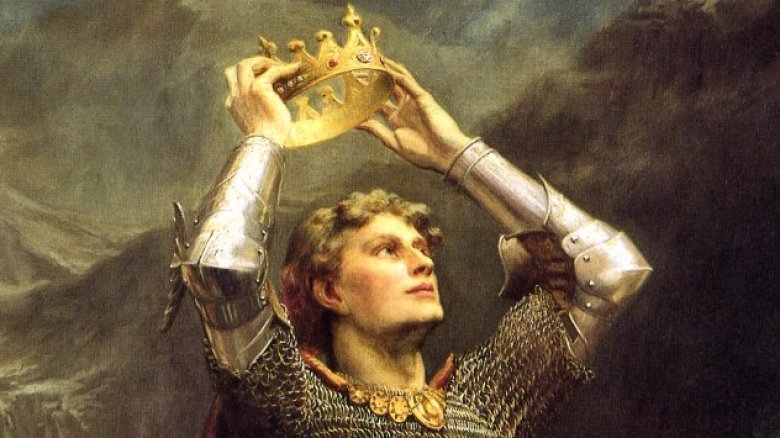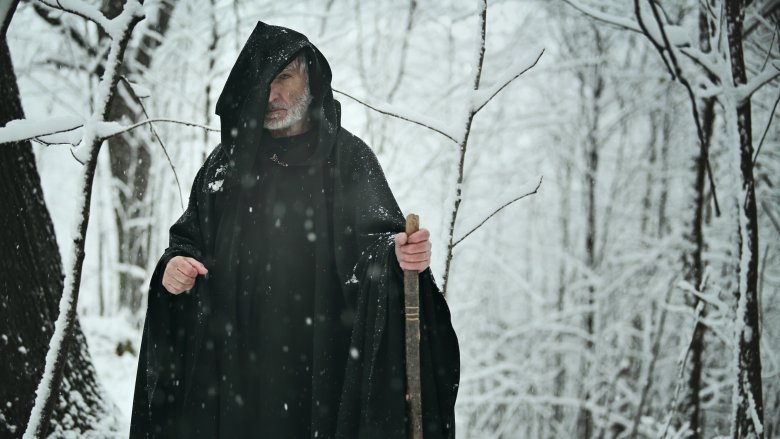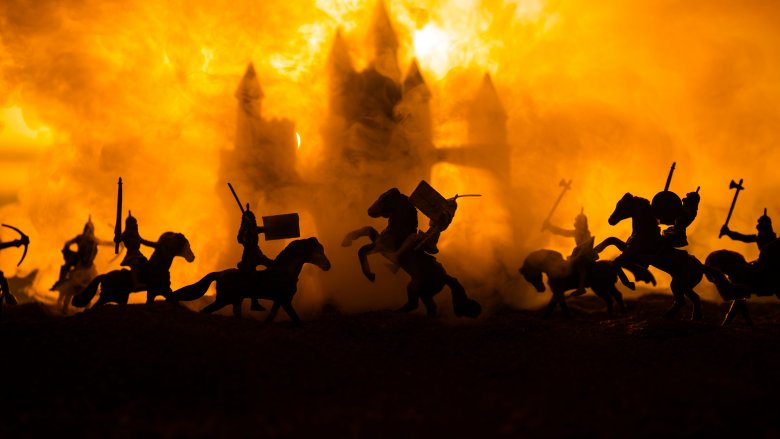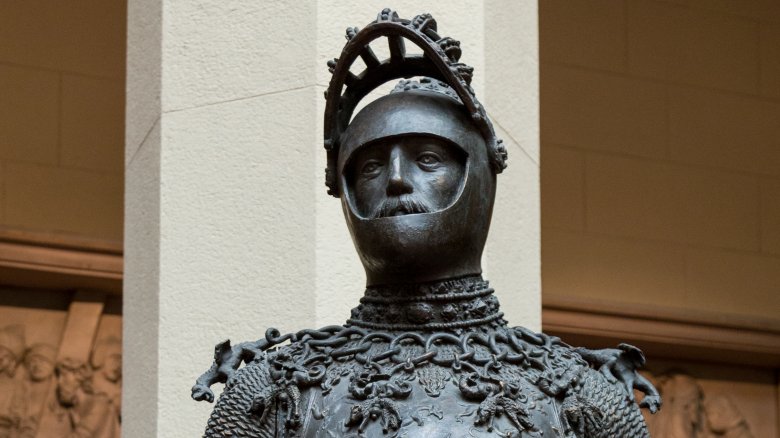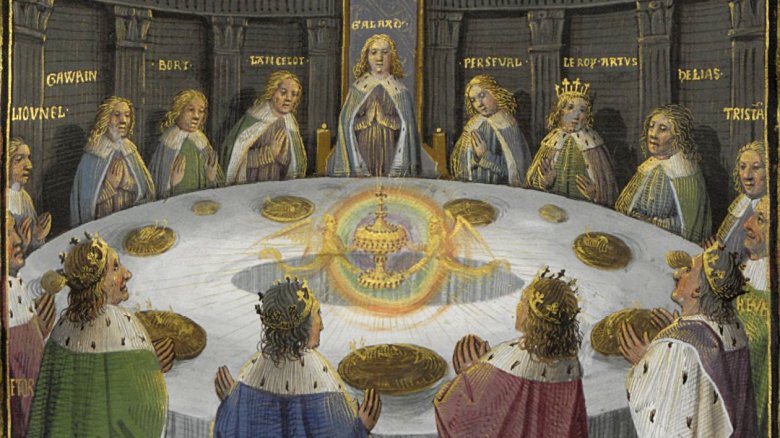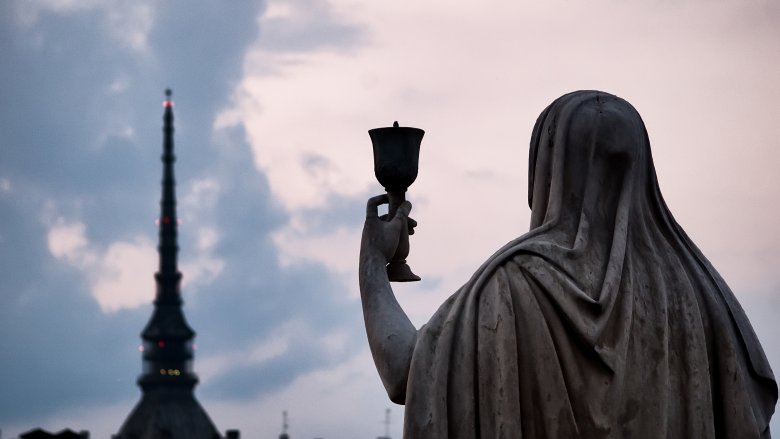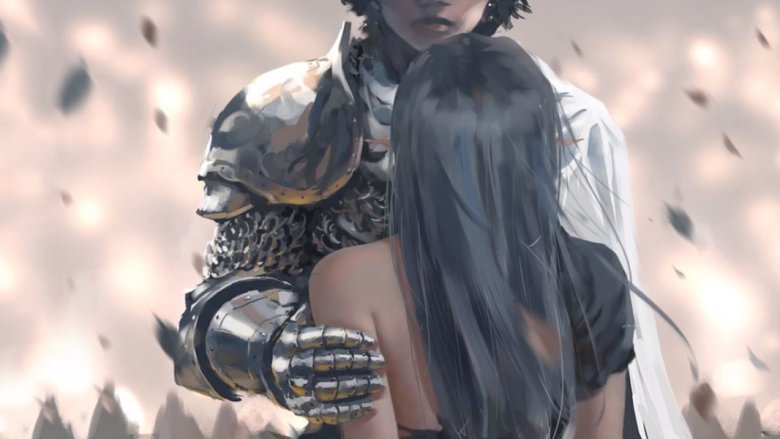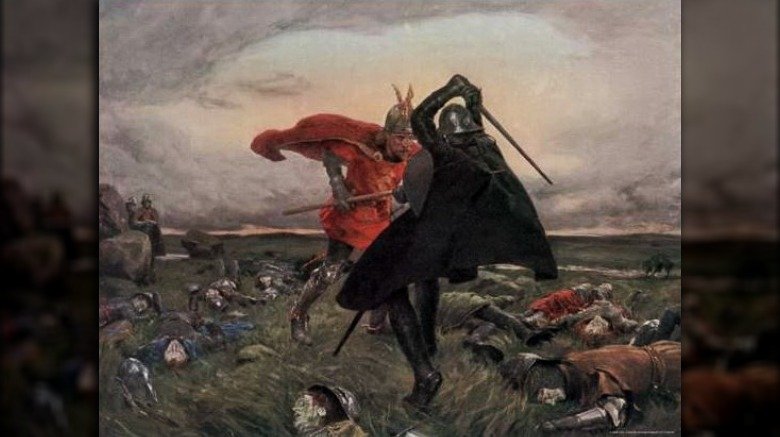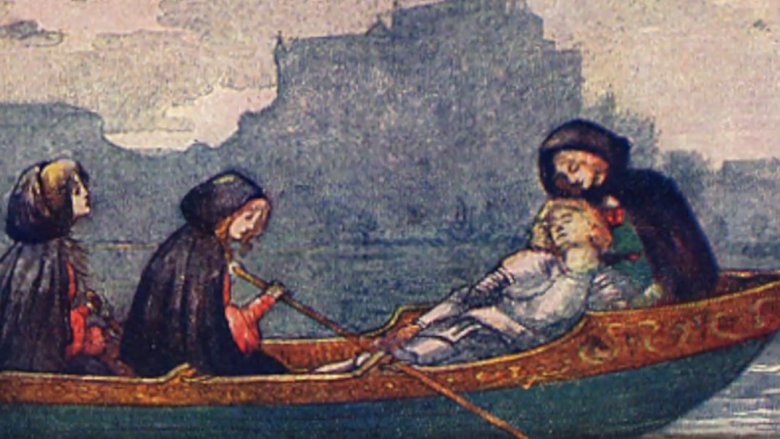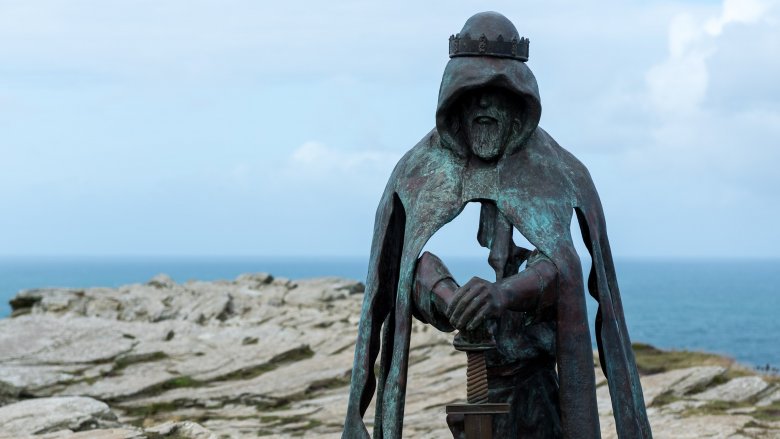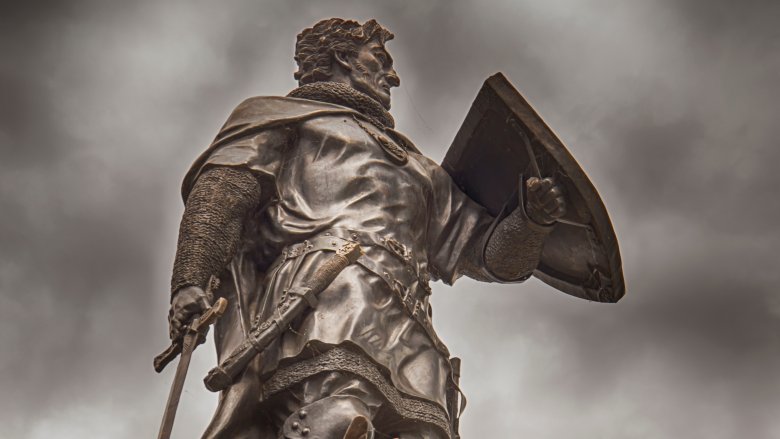King Arthur's History Finally Explained
There are some heroes whose stories run through history, always turning up in new forms. Beowulf is an obvious one. Robin Hood is history's eternal middle finger to greedy capitalist overlords. Everyone knows about that super strong son of Zeus, as well, though whether you call him Hercules or Heracles is a whole other debate. Even more recent countries like the U.S. have their tall tales, like John Henry hammering those railroads.
Then, you have King Arthur, the saintly monarch of Camelot. When painted in broad strokes, Arthur's tale is a classic old yarn about a scrappy kid who pulls a weapon out of some rock, becomes everybody's favorite king, has his knights sit around a circular table, and finally gets screwed over by his villainous son. When this legend is examined on a deeper level, though, it proves itself to be one of the world's most passionate — and surprisingly tragic — epics.
It was a dark, stormy night, and black magic was afoot ...
All the best fantasy stories begin with an ominous prologue, and the Arthurian legends are no exception. Basically, according to Hero of Camelot, this whole shebang begins when the mighty king Uther Pendragon is busy doing a great job ruling over his subjects, but having problems with the whole "heir" thing. Adoption wasn't an option, apparently. Because soap opera triangles were just as popular in the Dark Ages as they are now, Uther's situation is further complicated by the fact that he has the hots for a woman named Ygraine ... who is, unfortunately, the Duke of Tintagel's wife. Off limits, dude. Anyhow, King Pendragon decides to vent these adolescent frustrations to his trusted adviser, a dusty old fella named Merlin.
Now, if Merlin were a good friend, he would've offered to be Uther's wingman on a tour through Camelot's local dive bars. Instead, the wizard casts a spell that transforms Uther into the duke for a night, thereby allowing him to secretly sleep with Ygraine — without telling her, mind you — and conceive a son. Uh, sketchy ethics? No kidding. Some versions of the story try to clean up the overall griminess a bit by having Ygraine secretly in love with Uther, as well, but the whole situation is rather icky.
Following Arthur's birth, according to PBS, Merlin whisks the cursed (or prophesied?) baby away, to have him raised as a peasant.
Merlin guides the boy Arthur to his future
Now, as the years go on, Uther Pendragon dies, leaving the blighted land without a king. While it would've been great if the people rallied to form a democracy, like Robin Hood might suggest, they instead mourn their lack of authoritarian rule, and are only comforted by some strange prophecy that the rightful king will be the person who can yank out the mystical Sword in the Stone ... which is, yeah, exactly what it sounds like. Meanwhile, that little baby has now become known a young squire named "Wart." Much to Wart's chagrin, he gets stuck training on Dagobah with Yoda ... er, sorry, Merlin, the same wizard who caused this mess in the first place.
Merlin, by the way, is a fascinating character unto himself. As Ancient Origins explains, early depictions of the wizard were only tangentially connected to the Arthur story, and sometimes portrayed him as a more demonic figure than the kindly trickster you know today. Regardless, according to the University of Rochester, Merlin's role in Arthurian legend is largely that of a mentor, who guides the young Arthur to step into the light, pull out the Sword in the Stone, and take his rightful place on the throne. It is at this point, according to HowStuffWorks, that King Arthur is hailed by the populace as the once and future king of England. Whoa!
... or, as Dr. Sam Beckett of Quantum Leap might say, "Oh boy."
Wait, so is the Sword in the Stone also Excalibur?
Okay, it's time to dust away some cobwebs. You're probably familiar with the Sword in the Stone fairy tale, even if only from the Disney version. You're also most likely aware that the adult Arthur wields the mythical Excalibur, a blade so sharp it puts Valyrian steel to shame. However, while many people are tempted to conflate the two weapons, and some versions of the tale do so, this isn't an accurate representation of most Arthurian legends.
What's the deal? Well, as the Ancient History Encyclopedia explains, the Sword in the Stone ends up getting shattered in Arthur's first battle. Oops! Following this, Arthur is gifted with Excalibur — referred to as Caliburnus or Caliburn in early accounts — by the magical Lady of the Lake, an underwater enchantress who comes from the magical island of Avalon, and apparently knows just when a young king needs a sword.
Wondering how this exchange takes place? Does Arthur have to sell his soul for it? No. HowStuffWorks says that, usually, it's as simple as Arthur strolling up to the lake, where she is already holding the blade up over the water's surface for him. Quick and easy!
King Arthur's many battles
While contemporary King Arthur adaptations tend to focus on all that Holy Grail stuff, early Arthurian legends were clear about the fact that Arthur's true achievements were his skill at wielding a sword and chopping up bad guys. King Arthur participated in lots and lots of battles, mostly against the dreaded Saxons. The Welsh monk Nennius wrote in The History of the Britons that Arthur — whom he described as being real person, though scholars have their doubts — led the charge in twelve separate battles.
Now, if you've seen the Lord of the Rings trilogy, you know how exhausting even one massive medieval battle can be, and according to History, the number of battles that Nennius places Arthur at occur in so many different times, and so many different places, that it would simply be impossible for Arthur to have fought in all of them. Sorry, Artie. That said, if Arthur was real, these accounts have led one historian, who hails from the University of Navarre in Spain, to speculate that Arthur must've been a military general rather than a king, according to the Independent.
In early depictions, King Arthur was kind of a sociopath
War is hell. Always was, always will be. Whether you're fighting with swords or dropping nuclear bombs, violence will never be the glorious, noble, or heroic thing that the government enlisting you might claim. Medieval warfare was particularly vicious, since you had to cut up people two inches in front of you, so it's unlikely that any dude who was in "twelve battles" (cough, cough) could've come away without some serious PTSD.
Here's the thing about King Arthur, though: his persona evolves with the years, to fit whatever new definitions of heroism is in vogue at a given time. Back in the Dark Ages, that meant he was celebrated for his ability to hack and slash his way through hundreds of enemy combatants, as opposed to the saintly idealist he's often painted as today. Honestly, the version of Arthur written by Nennius — and later elaborated on in the 12 century by Geoffrey of Monmouth, according to History — was less of an ancient British Captain America and more like a brutish Punisher on steroids, wearing a crown: in the battle of Mount Badon, for instance, Arthur allegedly slaughters almost a thousand men in one fell swoop, all by his lonesome, with no help. Not the most likable hero around, as the Archaeological Institute of America puts it, but times have (thankfully) changed.
All hail the Knights of the Round Table
As Arthur grows into a wise, mighty king, he sets up shop in a mythical walled castle/city known as Camelot, as Ancient Fortresses tells it. Camelot is an insanely cool place, if you haven't heard. It's about as utopian as you can get in a time where electricity and modern flush toilets are still centuries away.
For a key example of just how progressive Camelot really was, look no further than Arthur's famous Knights of the Round Table, named as such because they assembled around a circular piece of wood that could magically seat 150 knights, according to LiveScience. Yes, that's a seriously inconvenient dining room piece, but the cool thing is that the Round Table is specifically designed so that no one — not even King Arthur himself — can sit at the head, rendering everyone equal.
Of the many knights who sat there, the most famous two are probably Arthur's top dog, Sir Lancelot, as well as Lancelot's son, Sir Galahad. Remember those two names, because they're both major players in the tale ahead.
King Arthur and the quest for the Holy Grail
The Holy Grail is no ordinary cup. Said to have been used by Christ at the Last Supper, according to the British Library, and to have later been used to catch some drops of his blood during the crucifixion, it has been a hot ticket item in many fantasy stories ... but none more so than Arthurian legend, where it's said that Artie and his knights must undertake an epic journey to rescue it from the wasteland where it is being guarded by the Fisher King. The Fisher King, despite his menacing name, is a rather sympathetic figure: he's afflicted by a painful wound that won't ever heal unless Arthur and company rescue the Grail. If they succeed, the Grail's recovery will also turn those wastelands back into plush meadows, or what have you. Good stuff.
Unfortunately, finding the big cup isn't a piece of cake, as Myths and Legends tells it. While there's no killer rabbits anywhere to be found, the Grail itself is invisible to all but the purest of hearts. Arthur can't see it, probably because of that aforementioned thousand man killing spree. Lancelot can't see it, either, because he's busy lusting after his buddy's wife (spoiler alert). The winner ends up being the virginal Sir Galahad, who saves the day at the cost of his life: seeing the Grail is so mesmerizing, and so wonderful, that the young knight falls dead mere moments afterward.
King Arthur's love and loss
Here comes the point in King Arthur's story where everything goes sliding downhill. Goodbye, utopia.
See, throughout King Arthur's reign, his greatest source of strength has been the joy and happiness he experiences with his beloved queen, Guinevere. Unfortunately, in the midst of all these epic quests, the queen falls in love with Arthur's top knight, Sir Lancelot, and the two become lovers behind Arthur's back, according to the University of Rochester. Now, if you live in the real world, you know this sort of thing never ends well. In the 21st century, affairs tend to lead to divorce papers, but in Arthur's time, it leads to Camelot falling into disarray as soon as Arthur finds out. In a completely villainous third act twist, according to HowStuffWorks, Arthur condemns Guinevere to death by execution, and assembles his forces against Lancelot. Sure, losing your queen sucks, but ... really?
In general, this sequence of events is usually portrayed as the beginning of the end. Camelot never recovers. Unfortunately, the worst is yet to come, because Arthur's own philandering ways are about to bite him in the butt.
Watch out for Mordred
Finally, now, the time has come for the great villain of Arthurian legends to enter the picture, and rip apart everything Arthur holds dear.
Meet Mordred. He's not a nice dude. Honestly, he's basically the Ramsay Bolton of this tale. Even more dangerously, according to the University of Rochester, he's also Arthur's bastard son — born of an accidentally incestuous coupling between Arthur and his half-sister Morgause, which was kept under wraps — as well as a traitorous Knight of the Round Table, and the usurper of Arthur's throne. That's a bad combo for Camelot ... but a fitting way to bring this story full circle, considering Arthur's own adulterous origins.
When Arthur goes riding off to kill Lancelot, as Early British Kingdoms tells it, he allows Sir Mordred to rule over the kingdom in his absence — for the record, he has no idea this guy is his son — and once Arthur is far enough away, Mordred takes the opportunity to pretend that daddy is dead, and claim the royal title for himself. Jerk. Soon enough, Arthur returns, which means he now has to wage war against Mordred. Their final showdown occurs during the battle of Camlann, according to Wiley, wherein Arthur takes down his evil son, but is mortally wounded in the process.
To Avalon, King Arthur goes
Okay, so even though King Arthur wins the battle of Camlann, Mordred manages to slash him up beyond the point of repair. Desperate times call for desperate measures, so the powers-that-be decide to ship off Arthur's injured body to the mystical Island of Avalon (remember, that's the place where Excalibur/Caliburn was forged) in the hope that maybe someday, the magical folks of this weird place can use their powers to patch him back up. And so, the great King Arthur sails away into the sunset, into an uncertain future, never to return. How very Lord of the Rings.
What happens after that, according to Legend of King Arthur, is a point of much speculation. Some say that he dies at Avalon. Others believe that he is placed in a cave, where he will rest until the day where Great Britain needs him again. There are some folks who believe he was transformed into a raven. (Bran, is that you?) No matter what, Avalon seems to be the end of the line for Arthur's earthly journey, and the beginning of his next, more metaphysical one. So it goes.
Heroic epic or epic tragedy? King Arthur's story, reexamined
The story of King Arthur is one for the ages. However, the way that society examines his classic narrative changes every few decades. Usually, as Newsweek puts it, Arthur has often been set forward as a noble hero whom all should aspire to be like. Other times, according to History, his name and image have been politically exploited for propaganda purposes by sinister figures like Henry VIII (yes, that Henry). In the 20th and 21st century, though, the icon that is "King Arthur" has been deconstructed in many fascinating ways. Much of the credit for this goes to author T.H. White, according to Vox, whose book The Once and Future King recreated Arthurian myths in a post-WWII context, positing Arthur as an idealist who — despite his best efforts — is unable to stop Camelot's slide into decadence, brutality, and feudalism. Harsh stuff. Another modern classic of Arthurian literature is Marion Zimmer Bradley's The Mists of Avalon, according to Lit Reactor, which focuses on the oft-ignored women in the story, showing them as developed human beings, with active goals, fears, and flaws, rather than merely side characters.
Because of these modern takes, King Arthur's legend is now sometimes read as a cautionary parable about the dangers of ambition, how war ruins everything, the loss of innocence, or what have you. Needless to say, the Once and Future King has become a far more tragic figure than he used to be.
So, was King Arthur real?
That's the big question, right? Unfortunately, don't expect an easy answer. The debate over whether the mythical King Arthur was based on a real individual is almost as fervent as the whole "historical Jesus" thing. A number of real historical figures have been cited as potential Arthur inspirations, according to HowStuffWorks, including the powerful military general Lucius Artorios Ambrosius, or the sixth century king of modern day Scotland/Ireland, Áedán mac Gabráin.
However, History points out that part of the problem with these debates is that Arthur didn't pop up in any historical accounts until Nennius came around in the ninth century, and Nennius ... well, he wasn't the kind of guy you'd trust to write a term paper, much less a historical document. Fordham University says that Nennius was known to be "unrestrainedly inventive," and suitably enough, his accounts strain credibility on multiple fronts. Because of this, some historians now find the subject of King Arthur painful to listen to, with archaeologist John Nowell Linton Myres once writing that, when it came to King Arthur, "No figure on the borderline of history and mythology has wasted more of the historian's time."
Ouch! Real or not, though, King Arthur's story has legs, and the big guy will probably keep on running for many centuries to come.
